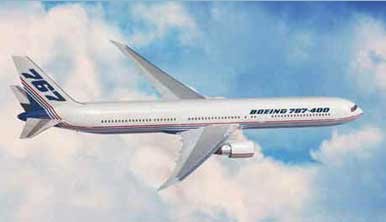Tue, May 13, 2003
They'll All Work On The Next-Generation Air Force Surveillance
System
 Northrop Grumman Corporation, The Boeing Company and Raytheon
Company officials agreed Monday to work together in developing the
U.S. Air Force's E-10A Multi-sensor Command and Control Aircraft
(MC2A). This innovative teaming agreement covers the Weapon
Systems Integration (WSI) efforts for the E-10A, which provides an
enhanced airborne ground surveillance and cruise missile defense
capability to the warfighter.
Northrop Grumman Corporation, The Boeing Company and Raytheon
Company officials agreed Monday to work together in developing the
U.S. Air Force's E-10A Multi-sensor Command and Control Aircraft
(MC2A). This innovative teaming agreement covers the Weapon
Systems Integration (WSI) efforts for the E-10A, which provides an
enhanced airborne ground surveillance and cruise missile defense
capability to the warfighter.
 "We will give the Air Force a best value program
by drawing on the legacy expertise each company brings to this
exciting new mission," said Chris Hernandez, Northrop Grumman's
vice president for Air Force Surveillance Programs. "We've
worked hard to build an agreement that will provide commanders with
the most responsive and technologically advanced ground
surveillance and battle management capability in the world at an
affordable price."
"We will give the Air Force a best value program
by drawing on the legacy expertise each company brings to this
exciting new mission," said Chris Hernandez, Northrop Grumman's
vice president for Air Force Surveillance Programs. "We've
worked hard to build an agreement that will provide commanders with
the most responsive and technologically advanced ground
surveillance and battle management capability in the world at an
affordable price."
 Increment 1 of the Air Force's evolutionary
acquisition program for the E-10A provides for an advanced airborne
ground surveillance and cruise missile defense capability. It
uses the Northrop Grumman/Raytheon Multi-Platform Radar Technology
Insertion Program (MP-RTIP) radar sensor coupled with a Battle
Management Command and Control (BMC2) system that is being competed
later this year. The teaming agreement announced Monday
covers the overall WSI contract, which is expected to be a sole
source award made later this month.
Increment 1 of the Air Force's evolutionary
acquisition program for the E-10A provides for an advanced airborne
ground surveillance and cruise missile defense capability. It
uses the Northrop Grumman/Raytheon Multi-Platform Radar Technology
Insertion Program (MP-RTIP) radar sensor coupled with a Battle
Management Command and Control (BMC2) system that is being competed
later this year. The teaming agreement announced Monday
covers the overall WSI contract, which is expected to be a sole
source award made later this month.
Under the agreement, Northrop Grumman is anticipated to be the
prime contractor and will be responsible for overall program
management and system engineering, mission system design, system
integration and flight test, and airframe modification. Primary
responsibilities for Boeing include major structural modification
design and kits, air vehicle analysis and performance assessments
and airworthiness testing.

Boeing will most likely produce the 767-400ER airframe for the
E-10A test bed under a separate contract with the government. In
addition, the Teaming Agreement anticipates that Boeing will take
the lead for any Increment 2 analysis and subsequent activities,
should the government decide to proceed with an additional
increment.
Increment 2 is not currently funded, but if implemented, is
expected to support Airborne Early Warning and Control (AEW&C)
with increased BMC2 functionality. Raytheon's primary
responsibilities include radar and radome installation, the
self-protection system, and support to system engineering, system
integration and test for the cruise missile defense
functionality.
More News
Minimum Friction Level The friction level specified in AC 150/5320-12, Measurement, Construction, and Maintenance of Skid Resistant Airport Pavement Surfaces, that represents the m>[...]
Aero Linx: Airpower Museum The APM owns 30 acres on Antique Airfield, including the south half of the N-S runway. It consists of three hangars, an annex, and a library. The museum >[...]
Patient Told The First Responders That The “Man Who Was In The Plane Was Flying At The Time Of The Accident And Had Overshot The Runway They Were Attempting To Land On.&rdquo>[...]
Klyde Just Can't Believe This Has Gotten To This Point... FMI: www.klydemorris.com>[...]
Also: Duffy Wants $$$, KS Airports, Morningside U’s Aviation School, New Airstrip In ID After 6 were killed in a helicopter crash over the Hudson River, several US Representa>[...]
 ANN's Daily Aero-Term (06.02.25): Minimum Friction Level
ANN's Daily Aero-Term (06.02.25): Minimum Friction Level ANN's Daily Aero-Linx (06.02.25)
ANN's Daily Aero-Linx (06.02.25) NTSB Prelim: Champion 7ECA
NTSB Prelim: Champion 7ECA Classic Klyde Morris (From 06.10.22)
Classic Klyde Morris (From 06.10.22) Airborne 05.30.25: Anti-Helicopter Bill, PW Strike Done, All-Electric Bristell
Airborne 05.30.25: Anti-Helicopter Bill, PW Strike Done, All-Electric Bristell





